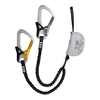Alexey Bolotov dies on Everest
On 15 May Russian alpinist Alexey Bolotov died above the Khumbu Icefall on the South Face of Everest.

 1 / 1
1 / 1
Russian mountaineer Alexey Bolotov
 archivio Denis Urubko
archivio Denis Urubko
Tragedy on Everest: on Wednesday 15 May the highly talented Russian mountaineer Alexey Bolotov perished above the Khumbu Icefall at circa 5600m. The 50-year-old had reached Base Camp on the Nepalese side of the mountain in mid-April intent on establishing a new route up the SW Face of Everest in alpine style together with Kazakh alpinist Denis Urubko but, for reasons which still need to be confirmed, Bolotov perished just above the Icefall. The body was discovered by Sherpa and Denis Urubko and on Thursday it was recovered and flown by helicopter to Kathmandu thanks to Simone Moro and Maurizio Folini.
Born on 20 January 1963, Alexey Bolotov was recognised as being one of the strongest Himalayan climbers of his generation. He took part in numerous incredible first ascents such as the Direttissima up the North Face of Jannu in 2004 and the great new line up the West Face of Makaly in 1997. Both routes which earned him a Piolet d'Or, the most prestigious award in mountaineering, to which one needs to add the nomination for his 1999 ascent of Thalay Sagar. These are all cutting-edge routes, recognised not only in the mountaineering world but also by the Russian Federation which awarded Bolotov with the "Order of Courage" for his ascent of Makalu and the Homeland Service Medal II Grade prize for his ascent of Lhotse Middle in 2001.
Lhotse in fact was the first Himalayan giant which Bolotov climbed. While for obvious reasons his mountaineering carrer began on his "home mountains" such as Peak Chantengri (6995m) and Peak Pobedy (7439m), both in Kyrgyzstan, at the start of the new millennium Bolotov began to explore the Himalayan peaks with a success rate which has few equals. Lhotse was followed by Everest in 2002, Dhaulagiri in 2005, Cho Oyu in 2006, K2 in 2007, Annapurna in 2008, Manaslu in 2009, Gasherbrum I and II in 2010, Broad Peak and Kangchenjunga neinl 2011.
This season the time had come once more for Sagarmatha, the Earth Goddess, ideally via a new route up the enormous SW Face. Bolotov and Urubko had just finished their acclimatisation period and were poised to launch their attempt. Fate wanted otherwise. Bolotov leaves a wife and two children.
Born on 20 January 1963, Alexey Bolotov was recognised as being one of the strongest Himalayan climbers of his generation. He took part in numerous incredible first ascents such as the Direttissima up the North Face of Jannu in 2004 and the great new line up the West Face of Makaly in 1997. Both routes which earned him a Piolet d'Or, the most prestigious award in mountaineering, to which one needs to add the nomination for his 1999 ascent of Thalay Sagar. These are all cutting-edge routes, recognised not only in the mountaineering world but also by the Russian Federation which awarded Bolotov with the "Order of Courage" for his ascent of Makalu and the Homeland Service Medal II Grade prize for his ascent of Lhotse Middle in 2001.
Lhotse in fact was the first Himalayan giant which Bolotov climbed. While for obvious reasons his mountaineering carrer began on his "home mountains" such as Peak Chantengri (6995m) and Peak Pobedy (7439m), both in Kyrgyzstan, at the start of the new millennium Bolotov began to explore the Himalayan peaks with a success rate which has few equals. Lhotse was followed by Everest in 2002, Dhaulagiri in 2005, Cho Oyu in 2006, K2 in 2007, Annapurna in 2008, Manaslu in 2009, Gasherbrum I and II in 2010, Broad Peak and Kangchenjunga neinl 2011.
This season the time had come once more for Sagarmatha, the Earth Goddess, ideally via a new route up the enormous SW Face. Bolotov and Urubko had just finished their acclimatisation period and were poised to launch their attempt. Fate wanted otherwise. Bolotov leaves a wife and two children.
Note:
| www | |
| www.mountain.ru | |
Latest news
Expo / News
Expo / Products
A trail running backpack ideal for running in any weather condition. Thanks to the HDry membrane, this backpack is fully waterproof.
Ergonomic, high-performance and robust quickdraw for high-level sport climbing.
Ccompact lightweight shock absorber with elastic arms for via ferrata.
Ocun Diamond S climbing shoes designed for maximum performance, comfort, and precision
An agile and lightweight mid-cut boot for mixed-terrain hiking.
Merino Wool Mountaineering Sock.



 Copia link
Copia link
























